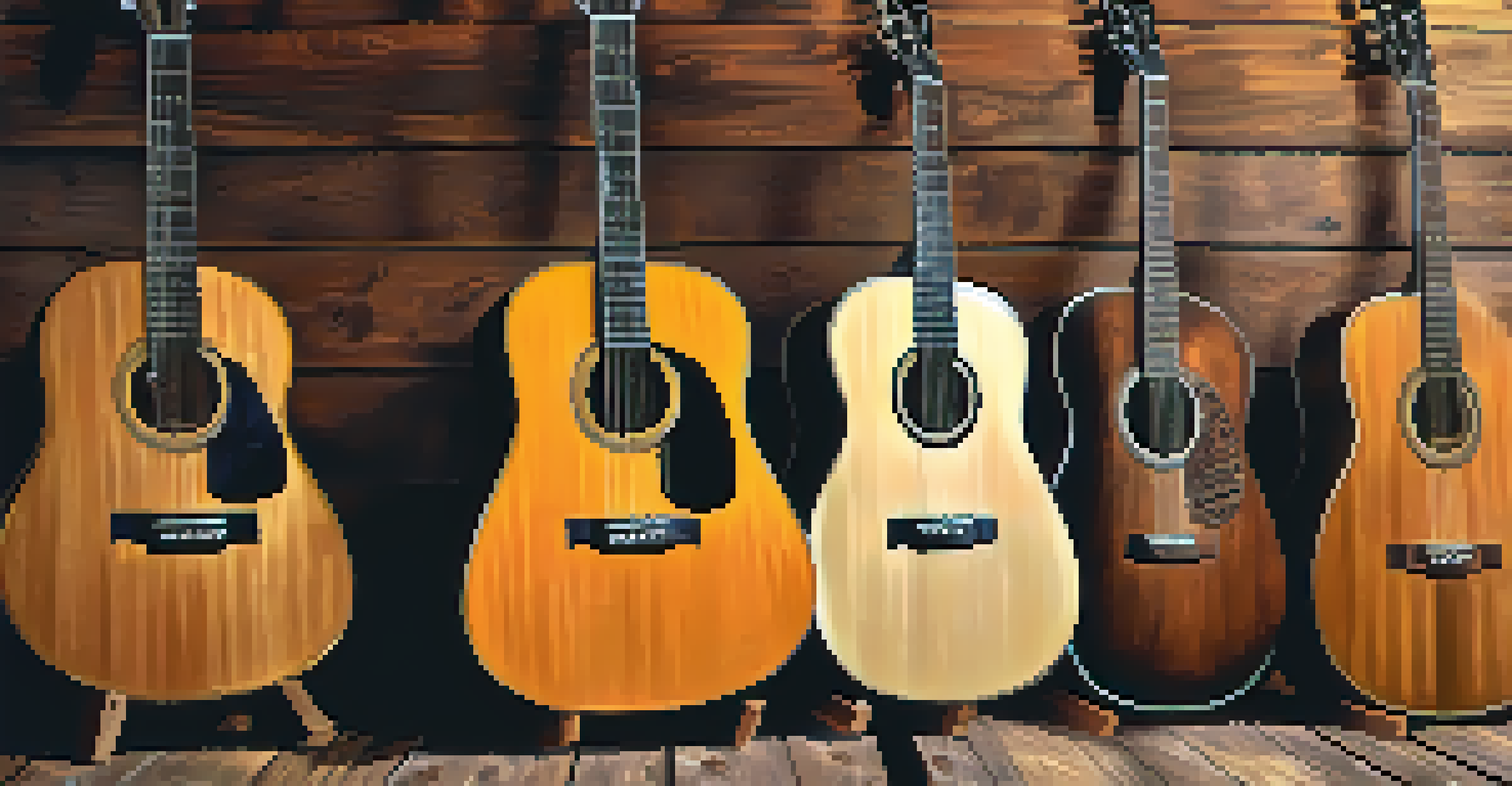The Influence of Bracing Patterns on Acoustic Guitar Sound

Understanding Acoustic Guitar Bracing Patterns
Bracing patterns are the internal structures that support the guitar's top. These patterns are crucial because they influence how the guitar vibrates when played. Common bracing designs include X-bracing, fan bracing, and ladder bracing, each offering unique tonal characteristics.
The guitar is a miniature orchestra in itself.
For instance, X-bracing is widely used in steel-string guitars, providing a balance between strength and flexibility. This balance allows the top to resonate freely, enhancing volume and sustain. On the other hand, fan bracing is often found in classical guitars, promoting a different tonal quality that emphasizes warmth and richness.
Ultimately, the choice of bracing pattern can significantly affect the overall sound profile of the guitar. By understanding these patterns, musicians can make informed decisions that align with their desired sound.
The Science Behind Guitar Sound Production
Sound production in an acoustic guitar stems from the vibration of its strings, which transfers energy to the guitar body. The body then amplifies these vibrations, creating the sound we hear. The role of bracing is to facilitate or hinder this energy transfer, impacting volume, sustain, and tonal balance.

When a player strums or plucks a string, it causes the top of the guitar to vibrate. The bracing pattern helps determine how freely this top can move, which in turn affects the overall sound projection. A well-designed bracing pattern can enhance the guitar's resonance, making the sound fuller and richer.
Bracing Patterns Shape Guitar Sound
The choice of bracing pattern significantly influences the tonal qualities, volume, and projection of an acoustic guitar.
Additionally, the material of the guitar top, combined with the bracing pattern, plays a vital role in the guitar's acoustic properties. Together, they create a harmonious relationship that defines the guitar's voice.
How Bracing Patterns Affect Volume and Projection
Volume and projection are essential aspects that many guitarists consider when choosing an instrument. A guitar with an effective bracing pattern can produce a louder sound with greater projection. This is often crucial for performances in larger venues or jam sessions.
Music is a world within itself; it’s a world full of sound.
For example, guitars with X-bracing typically offer a more powerful sound due to their structural design. The crisscross pattern allows for a larger movement of the top, which can amplify sound waves more effectively. Conversely, designs like fan bracing may result in a softer tone suited for intimate settings.
Ultimately, understanding how different bracing patterns influence volume can help musicians select the right guitar for their playing style and environment. It’s all about finding that perfect balance between power and subtlety.
Tonal Qualities of Different Bracing Patterns
Different bracing patterns yield distinct tonal qualities, influencing how a guitar sounds across various styles of music. For instance, X-braced guitars are often noted for their bright and balanced tone, making them popular in bluegrass and folk genres. In contrast, fan-braced guitars provide a warmer, softer sound ideal for classical and fingerstyle playing.
The tonal differences arise from how each bracing pattern interacts with the wood of the guitar. As the top vibrates, the bracing supports it in specific ways that can emphasize or dampen certain frequencies. This means that players can choose a guitar that complements their preferred genre.
Sustain Affects Musical Expression
Different bracing designs can enhance or shorten sustain, impacting how notes resonate and the overall musical experience.
Moreover, the interplay between bracing patterns and the type of wood used can further refine tonal characteristics. Musicians looking for specific tonal attributes should consider both the bracing and the wood to achieve their desired sound.
Bracing Patterns and Sustain: What to Know
Sustain refers to how long a note lingers after being played, and it’s a critical aspect of an acoustic guitar's sound. Bracing patterns significantly influence sustain by determining how the guitar body vibrates and maintains energy. A well-designed bracing pattern can enhance the sustain, allowing notes to resonate beautifully.
For example, guitars with X-bracing often exhibit excellent sustain due to their structural integrity, which helps maintain vibrations longer. This characteristic is particularly appealing for solo performances, where sustained notes can create a more expressive sound.
Conversely, some bracing patterns may result in shorter sustain, which can be desirable for certain styles, like strumming chords in rhythm-heavy genres. Understanding how bracing affects sustain helps musicians choose the right guitar for their artistic expression.
The Impact of Bracing on Playability
Playability is an essential consideration when selecting an acoustic guitar. It encompasses how comfortable and easy the guitar is to play, which can be influenced by the bracing pattern. A well-designed bracing system can enhance playability by allowing for a lighter touch while still producing a rich sound.
For instance, guitars with lighter bracing may be easier to play, offering a responsive feel that allows for intricate fingerpicking. This can be particularly beneficial for beginners or those looking to play complex pieces effortlessly. On the other hand, heavier bracing may provide durability but could make the guitar feel stiffer.
Playability Matters for Musicians
The interplay between bracing patterns and playability is crucial, as it affects comfort and responsiveness while playing.
Ultimately, the balance between bracing and playability is key for musicians. Finding a guitar that feels good to play while still delivering the desired sound will enhance the overall musical experience.
Choosing the Right Bracing for Your Guitar
When it comes to selecting an acoustic guitar, understanding bracing patterns can help you make an informed choice. Each player has unique preferences, and the right bracing can complement your style. Whether you favor fingerpicking, strumming, or solo performances, the bracing should align with your musical goals.
It's advisable to try out different guitars with various bracing patterns to see how they feel and sound in your hands. Pay attention to how each guitar responds to your playing style, as this will guide you in finding the ideal match. Don't hesitate to consult with experienced players or music store professionals for insights.

Ultimately, the journey to finding the right bracing pattern for your guitar is a personal one. Embrace the exploration and enjoy the process of discovering the sound that resonates with you.